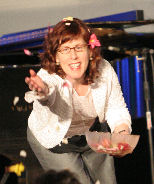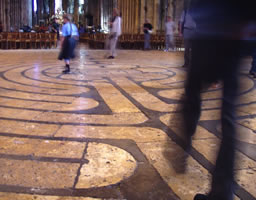|


The Shadow of Darkness
by Honora Foah
Co-president & Creative Director
Mythic Imagination Institute
If you are willing to look into the darkness for a long time, you will begin to be able to see it cast its shadow. This is the reward of the descent. The edges of the dark begin to glow, and standing before you is night's lover, radiantly entwined with her.
He is illuminated and she is rich with mystery.
These are images and lines from my opera, The Birth of Color: A Marriage of Darkness and Light. It was the piece I was working on when the need for Mythic Journeys arose. The Birth of Color has had its own rises and descents. Starting as a story I wrote as an emergency fill-in for a small festival that was lost to a publishing dispute, the story that was to have begun the festival and given it a context, The Birth of Color evolved quickly into a theatre piece. Before it was even completed, it was requested for a Sophia Conference in Chartres Cathedral. That was fitting, since both the story and the little Midsummer Solstice festival had grown out of an amazing salon that met for a year to talk (for hours and hours and hours) about Sophia. We had listened together to Robert Powell's tapes about Sophia, and so it was fascinating that it was Robert Powell who asked for The Birth of Color to be performed in Chartres.
This story is so long and strange. I had no idea when I sat down to write about descent that this is what would come out. Anyway.
In 1992, while putting together the World Expo Pavilion for the United Nations in Genoa, Italy, we had commissioned a young composer, Tristan Foison, to write the music for an exquisite show on the seven underwater wonders of the world. I'd loved the results of that collaboration, so I asked Tristan if he wanted to work on The Birth of Color. He agreed, as did, through another series of remarkable coincidences, the poet, David Brendan Hopes (whose work I cannot recommend highly enough-as far as I am concerned he's in a league with Gerard Manley Hopkins).
 So, there we were. A wonderful choir from Atlanta was going to be touring in Europe just at the time we would need to do the performance in Chartres. They began practicing the music and gave a concert of excerpts in an Atlanta church. I spent many hours in Chartres working on the story and the staging. I had the astonishing experience of being in the cathedral for a full day, without the chairs over the labyrinth, essentially alone, except for an Italian film crew who were also working there and for whom the church had been closed to the public. So, there we were. A wonderful choir from Atlanta was going to be touring in Europe just at the time we would need to do the performance in Chartres. They began practicing the music and gave a concert of excerpts in an Atlanta church. I spent many hours in Chartres working on the story and the staging. I had the astonishing experience of being in the cathedral for a full day, without the chairs over the labyrinth, essentially alone, except for an Italian film crew who were also working there and for whom the church had been closed to the public.
Then one day about three months before the performance, I received a letter from the new rector of the Cathedral, essentially saying that The Birth of Color was not theologically correct enough to be performed in the church and that they were not going to permit the performance. I suppose I could have taken this as a badge of honor, but I was crushed and went into a hole that was not mitigated by the stories people told me to cheer me up about famous artists who had also been forbidden to perform in Chartres, notably, Olivier Messiaen. Messiean was eventually allowed to perform once, and only once, when Charles DeGaulle intervened. Not having the general in our court, we were out.
The day we were supposed to have had the performance, my son graduated from high school and my mother was diagnosed with a relapse of melanoma.
Not to give up, though the dirt was falling in little rivulets from beneath my feet down into the open earth, we began discussions with the Atlanta Symphony about doing the piece. The Atlanta Symphony Chorus is arguable the best chorus in the world having been started and conducted by that beloved master of choral music, Robert Shaw. Their interest stemmed in part from their interest in Tristan. They were scheduled to perform another piece with him in the near future. Round about that time, a choral work of Tristan's was performed in the National Cathedral in Washington, DC. Unfortunately, the piece that bore his name was not actually written by Tristan. As the plagiarism was discovered, we were all in the middle of a baffling scandal. Why in the hell had he done that? His own music was wonderful. Tristan not only fell into a pit, he dug a tunnel back to France, and I have never been able to find him again. Ah, the pit.
Sometime later, I met with the director of the performing arts center in Lillehammer, Norway, Jorgen Damskau, about doing The Birth of Color as the centerpiece of the 10th anniversary celebration of the Winter Olympics that had been held there. One of our meetings was held in the Norwegian Parliament with a member who was active with the Ministry of Culture, a musician himself and an enthusiast about the piece. They were very excited about The Birth of Color, because it is a love story about Darkness and Light. At the opening ceremony of the Lillehammer Winter Olympics in 1994, the theme of the pageant had been the war between Darkness and Light, and Jorgen, who had been the director of that ceremony, felt that The Marriage of Darkness and Light was the image of the evolution of our understanding. I was very moved by that and by the way they spoke of their own experiences as northern people living within such an extreme environment of Dark and Light.
The other amazing thing was that the venue for the performance was to be outside on a frozen waterfall, cascading with the theatrical lighting of all the colors, while the audience stood on the frozen river. I attended another performance done this way (and nearly froze my ass off) and was wonder-struck.
The 10th anniversary celebration hired a new director. He felt the show should be rock n roll. I think they got U2?
The Birth of Color, A Marriage of Darkness and Light was actually one of two stories I wrote as contrapuntal images for that original solstice celebration. As I began to flesh it out, I realized that it and the other story were actually part of a cycle that was emerging in my mind. The cycle, which now is seven works, is called Recombinant DNA. In despair at the failure to produce the first piece, I decided to simply write the other pieces in the cycle. I felt unable to go out into the world and try to put it all into production. Too beat-up. Just do the work, get it down, retreat.
I was well along with the next two scripts, though feeling sort of smashed up from taking care of my mom and every other bloody thing, so I applied for a residency at an artist's colony to see if I could get it done by being completely solitary. Sit in the dark, watch for the liminal dawn. Then Michael Karlin called. I had consulted with him and John Adcox as Mythic Imagination Institute was getting started, and was now on the Board of Directors, but knew very little about what was happening day to day. There's another descent story here, for another day, but suffice it to say they needed help. Sure, I could help for a few days.
That was three years ago. Recombinant DNA lies in a cave at the bottom of the sea in a glass casket, waiting for a kiss to awaken her. Mythic Journeys is a wild ocean of possibility, personalities, splendid realities, failures, successes, relationships, love and fear, stories stories stories.
You never know what will become visible as you stare into the dark. The bogeyman shapes, the illusions, give way to the truth of your life that is waiting down there in the dark for you. Then it asks a question. Then you have to answer. Who knows what lurks in the hearts of men-and women—?
The shadow knows. The shadow of darkness is the light. And they love each other.
Return to Passages Menu
Subscribe to the Passages e-newsletter
|

